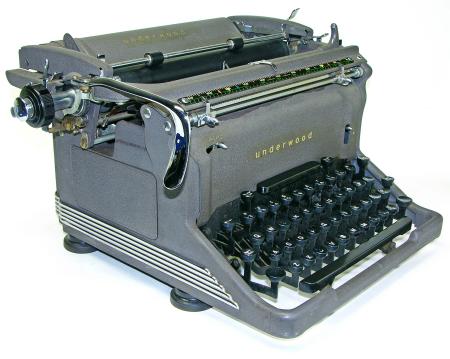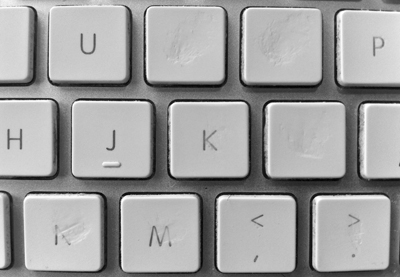When  our kid started using a computer in the seventh grade, I got him a copy of Mavis Beacon so he’d learn how to touch-type.
our kid started using a computer in the seventh grade, I got him a copy of Mavis Beacon so he’d learn how to touch-type.
I didn’t see him using the program, but I did see him typing. So I asked him what was up with that. He said “I looked at it a couple of weeks ago. It was good.” I asked, “Did you learn to touch type from it?” “Sure,” he said. “It has tests. I used them. I did fine.”
So I asked him to show me. He did. First try: 30 words per minute. Second, 45 wpm.
I took typing in the seventh grade ,which ran from September 1959 to June 1960.  It was a year-long class, one period per day. My typewriter at school was an early-Fifties Underwood Rhythm-Touch like the one on the left. For practice at home my parents got me a WWII-era Underwood that looked exactly like the code machine.
It was a year-long class, one period per day. My typewriter at school was an early-Fifties Underwood Rhythm-Touch like the one on the left. For practice at home my parents got me a WWII-era Underwood that looked exactly like the code machine.
I got an F in my first semester of typing class, because I made a lot of mistakes. I got a D in my second semester, for the same reason. For what it’s worth, I doubt anybody in that class has done more typing since then than I have. Or have worn out more keyboards. Such as the one on the right, which I’m using now.
My handwriting, long neglected, looks about as good.
Some old habits died hard. Here they are:
- Returning the carriage after the bell five spaces before the end of a line.
- Wanting to set tabs the old-fashioned way, feeling the physical insertion, literally, of a metal tab into the carriage path.
- Double-spacing between sentences. Not doing this was my most common error, back in typing class.
- Hyphenating long words at the ends of lines.
- Indenting the first line of a paragraph, with a tab five spaces in.
For years I hated word processing without hyphens, and double-returns between paragraphs with no indents. But after awhile I became accustomed to that new norm, and came to appreciate its benefits as well. (For example, when copying and pasting a bunch of text and not having to take out the hyphens and indents that only made sense in the old layout.) I also taught myself to restore my original proclivity to single spaces between sentences.
As for typing speed, I have no idea how fast I am now. What I love about not knowing is that it truly doesn’t matter.
Leave a Reply